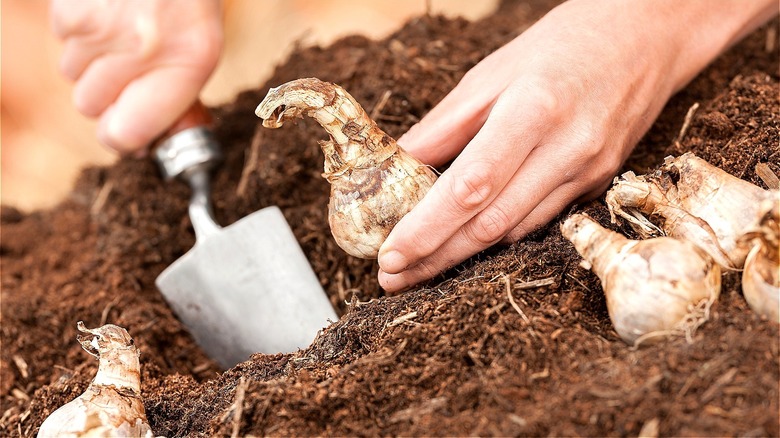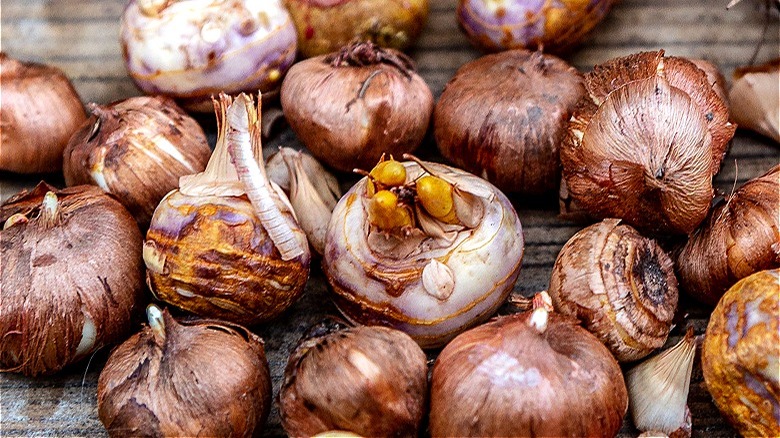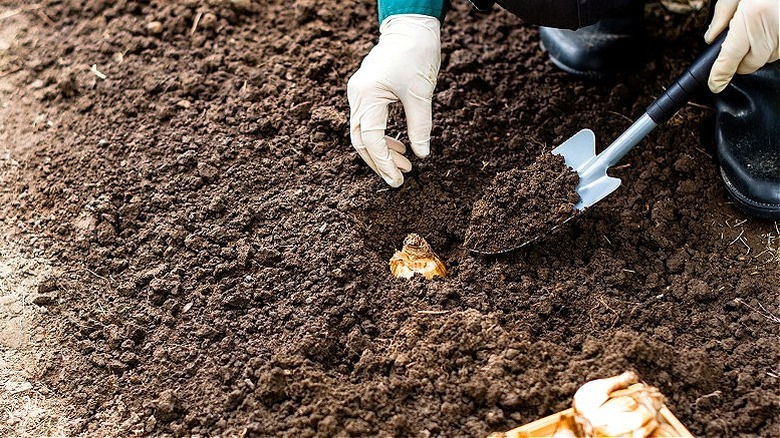The Popular Daffodil Planting Myth You Should Skip This Fall
The promise of beautiful spring flowers is always a good reason to put the time into planting fall bulbs, but doing so properly is essential to ensure those blooms actually happen months later. A common mistake with planting daffodils is believing you should soak the bulb for some time before you plant it. That's a common myth, as for most flower bulbs, soaking them increases the risk of damage to the bulb and the development of disease.
This myth stems from the fact that daffodil bulbs typically have small fibrous-like roots at their base, which some believe means they need to be kept wet in order to stimulate and encourage growth. However, those tiny root systems are quite delicate and susceptible to disease. Allowing the bulb to sit in and soak up a lot of water means it's going to be at a higher risk of developing a condition called root rot, which could eliminate the bulb's ability to grow at all.
Hydration is important, but it's more effective and safer for the plant if the bulb gets it from the surrounding soil instead of whatever moisture it absorbs during soaking. Daffodil bulbs can be hearty growers that don't need a lot of fuss; though, there are a few things you can do to encourage protection over the winter months and beautiful blooms once spring arrives.
Why soaking daffodil bulbs in the fall isn't a good idea
There are a lot of myths about how to ensure your daffodil bulbs make it through the winter and actually bloom. After putting in all the work planting them and waiting patiently through the winter, it's devastating when there's no bloom. That's exactly why you don't want to soak daffodils. Doing so traps water within the bulb, which may not seem like a bad thing, but it can lead to the rapid growth of harmful bacteria that cover the root ball and root system itself.
Those tiny hairs are meant to seek out moisture and nutrients once they're in the ground, which they do naturally. When you plant the bulb in the right environment, it'll begin to grow and expand outward, using the energy contained within the bulb to become established. That expansion occurs as the plant starts to seek out moisture. You want them to do this.
There is one time when soaking daffodil bulbs for about 12 hours can help, and that's when you haven't planted them in the early- to mid-fall, the best time of the year to plant daffodils. If you're planting them a few days before the likely first snow, soaking them for a short amount of time like this helps stimulate the root's growth so that they continue to rapidly set prior to the hard onset of winter. Even then, though, it's rarely ideal to submerge the bulb in water due to the risk of root rot.
The better way to give daffodil bulbs the best chance
Hydration is important to the success of daffodil bulbs, but there are several other steps to take to minimize disease risk. Start by planting healthy, hearty bulbs that aren't overly dried out. That often means that, no matter how much you soak them, they may not come back. Next, be sure the actual ground you plant them in is moist (not necessarily saturated, but moist). You don't want the bulbs to sit in water either, but instead to seek out water as the root system grows. Planting daffodils in the fall helps ensure this since the ground in many areas is already rather moist.
If the soil is dry and well-draining, water the bulbs after you've completed the planting. This will allow the roots to get just enough moisture without sitting in bacteria-heavy water. It's also a myth that you need to add a lot of fertilizer to the soil when planting them. Like water, too much fertilizer, especially chemical-based, will damage those roots. Instead, use an organic bone meal addition to the soil.
If you're doing some container gardening with bulbs, use a terra cotta planter for daffodils. Soak the pot itself overnight or for a few hours, and then plant the bulbs in lightly moist soil. One more myth to bust is that there's a benefit to soaking bulbs in hot sauce to ward off squirrels. It typically doesn't work, is expensive, and can damage the bulb.


